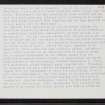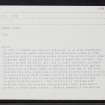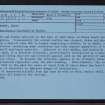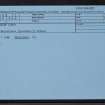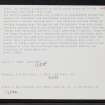Lewis, Bhaltos, Cnip
Midden (Period Unassigned), Souterrain (Prehistoric), Wheelhouse(S) (Iron Age)
Site Name Lewis, Bhaltos, Cnip
Classification Midden (Period Unassigned), Souterrain (Prehistoric), Wheelhouse(S) (Iron Age)
Alternative Name(s) Kneep; Valtos
Canmore ID 4009
Site Number NB03NE 17
NGR NB 0980 3659
Datum OSGB36 - NGR
Permalink http://canmore.org.uk/site/4009
- Council Western Isles
- Parish Uig
- Former Region Western Isles Islands Area
- Former District Western Isles
- Former County Ross And Cromarty
NB03NE 17 0980 3659
Stonework and midden material in the face of sand dunes on Kneep beach was eroded by winter gales. Consequently the eroded section was cleaned, drawn and photographed, revealing a deposit some 26m in length comprising a midden, 1m in depth, of dark sandy material containing many intrusions and with copious quantities of bone, pottery, marine shell and burnt material. Adjacent to this midden, and sealed by a thick layer of dark sand, is a drystone structure, provisionally interpreted as a wheelhouse, its curved wall being dug into and revetted against sand on the pattern of many Hebridean wheelhouse sites. At present the structure appears to be virtually intact and the fallen stonework represents only the wall backing. Unfortunately the rate of erosion is such that in the past two years at least 2.5m of these dunes has been lost and the structure is therefore in imminent danger of destruction.
Pottery of characteristically Iron Age type as well as bone, marine shell, and a bone bobbin were all found in the section.
I Armit 1986.
In 1987, a trench was laid out 10m by 6m in an area immediately behind the high dunes containing the structure, noted in 1986. Excavation quickly revealed midden across the entire trench under windblown sand, in places only a few cm below the surface. The midden, as well as being very rich in shell and bone, included quantities of later prehistoric pottery decorated with applied cordons, and in forms common to the early Iron Age of the area. Revetted into this midden was a structure closely similar in plan to souterrains or earth houses reported from early excavations in the Western Isles, ie, a long curving passage built of sand revetted drystone masonry. The structure is infilled with windblown sand and contains characteristic later prehistoric pottery in these upper levels. Several rebates in the walling hint at a structural complexity unrecorded on other sites of this particularly poorly known type.
The most promising structure on the site is a substantial and well preserved drystone roundhouse sealed beneath midden containing cordoned pottery. Only one part of the arc of this structure was within the area of the trench and this revealed several courses of drystone walling, corbelling towards the top. Voids in the rubble infill made visible two stone built 'aumbries' or 'boles' in the wall. The area exposed was not enough to confirm the existence of radial piers but the location, visible structure and apparent date of the structure would all seem to point to the conclusion that is a wheelhouse or related structure.
D W Harding and I Armit 1987.
Rescue excavations in the area of a proposed sewerage trench and sea-wall were carried out from March-April of 1988 on this machair site on the croft at No. 11 Kneep. The site yielded a complex structural sequence relating to the building, development and final abandonment of a wheelhouse settlement of sand-revetted structures. The exceptional degree of preservation of the structures enables the detailed reconstruction of building techniques employed.
The earliest structures on the site were two wheelhouses, linked by a connecting entrance. They conformed to the typical floor plan and building style of the type, although both were relatively small at c8m in diameter. Two of the cells of Wheelhouse 1 survived intact with corbelled roofs rising from the piers. Wheelhouse 2 had been bisected by tidal erosion and was much less well preserved, although still exceeding 2m in height. This wheelhouse had never been completed and had been modified to form an annexe cell for Wheelhouse 1.
The imminent total destruction of this structure enabled its controlled dismantling during the excavation to give information on construction techniques complementary to that derived from Wheelhouse 1. The wall section showed that the enclosing wall of the structure was only one stone in thickness and backed directly into the natural sand dune. No foundation material had been laid for either walls or piers. Behind the wall, deposits of an apparently votive nature had been carefully placed, including a small intact everted rim jar decorated with an applied cordon. The structural development of the complex almost from its construction onwards shows a history of modification and ad hoc stabilisation of the increasingly unstable Wheelhouse 1. Piers were buttressed, aisles blocked, posts inserted etc. Throughout the occupation the basic spatial arrangements remained remarkably regular with the replacement of cells and outbuildings directly over their predecessors. The final phase of occupation consisted of the insertion of a long revetted passage-like structure or 'souterrain' into the wheelhouse, reusing two wheelhouse cells and much of the walling. After abandonment this structure was apparently de-roofed and filled quickly with sterile windblown sand. No further occupation or cultivation occurred in the excavated area after this time.
The entire sequence lacks any evidence of abandonment phases and appears to represent the continuous occupation over a lengthy period of a single farming unit. The material culture shows no obvious changes over the period and the pottery from each phase contains similar motifs characteristic of the Hebridean Iron Age. Aside from decorated pottery, finds comprised a typical range of the types expected from a wheelhouse site in the Hebrides; bone preservation was good and copious quantities of worked bone and antler were recovered including a fine cetacean bone comb. A number of rotary querns were found incorporated into walling and evidence of iron and bronze-working was present despite few artefacts of these materials.
I Armit 1988.
Publication Account (2007)
NB03 2 CNIP ('Kneep')
NB/0980 3659
This dug-out corbelled wheelhouse with souterrain attached, and second attached dug-out wheelhouse, was in the sand dunes on the shore near the village of Kneep, Uig, on the west coast of Harris. Although the final report has not appeared there are several detailed summaries of the work in print. Since the well preserved roundhouse was threatened with destruction by sea erosion there was a rare opportunity at this site to gradually demolish the building during excavation and thus to recover a complete site sequence. Only a brief account of the site is offered here – a summary of the interim reports.
1. Discovery
In 1986 stonework and midden material in the face of sand dunes on Kneep beach was exposed by winter gales. Cleaning of the section revealed a deposit some 26m in length comprising a midden, 1m in depth, of dark sandy material containing many intrusions and with copious quantities of bone, pottery, marine shell and burnt material. Adjacent to this midden, and sealed by a thick layer of dark sand, was a drystone structure which subsequent excavations in 1988 showed to be a wheelhouse [3]. Only those parts of the site directly threatened by building operations were explored.
2. Site sequence [3]
The phases of Iron Age settlement deduced to have occurred on the site were as follows.
Phase 1: the two wheelhouses – 1 and 2 – with interconnecting passage.
Phase 2: Wheelhouse 1 unstable but still in use, new hearth laid; Wheelhouse 2 infilled and the cell-like Structure 3 built into its debris. Several other structures appear to belong to this phase.
Phase 3: the various small cells were replaced by Structure 8, the souterrain; Wheelhouse 1 continued in use.
3. The 1988 excavations
Excavations quickly revealed midden material across the entire trench under windblown sand, in places only a few cm below the surface. The midden, as well as being very rich in shell and bone, included quantities of later prehistoric pottery decorated with applied cordons, and in forms common to the Iron Age of the area.
Phase 1: The roundhouse settlement. The site yielded a complex structural sequence relating to the building, development and final abandonment of a roundhouse settlement of sand-revetted (that is, dug-out) structures [3, Illus. 3]. The exceptional degree of preservation of the structures enabled the detailed reconstruction of building techniques employed. The whole complex was sealed beneath a midden layer containing cordoned pottery, indicating that the settlement was not occupied beyond the middle Iron Age.
The earliest structures on the site were two dug-out wheelhouses, linked by a connecting entrance. They conformed to the typical floor plan and building style of the type, although both were relatively small with internal diameters of about 8m. Two of the bays (sometimes called cells) of Wheelhouse 1 survived intact with their corbelled stone roofs rising from the tall piers.
Two of the bays of Wheelhouse 1 were intact with their stone slab roofs still in position. This building is thus similar to the two almost intact ones at Jarlshof in Shetland (HU30 1), having stone piers which widen as they rise (to reduce the span of the bay to be roofed) and with overlapping flat stones forming the roof of each bay.
Wheelhouse 1 had eight stone piers forming the same number of bays, in one of which was the entrance passage – in the south-west. The overall internal diameter was 7m (23.0 ft) and the inner circle defined by the pier ends was only 3 - 4m (9.8 - 13.1 ft) in diameter. There was a paved central hearth but the primary occupation deposits were not fully explored because of the constraints of space and safety.
Wheelhouse 2 had been bisected by tidal erosion and was much less well preserved, although still exceeding 2m in height. This roundhouse had never been completed and had been modified to form an annexe for Wheelhouse 1. The imminent total destruction of this building allowed its controlled dismantling to take place during the excavation so that information was obtained on its construction techniques, complementary to that derived from Wheelhouse 1. The wall section showed that the enclosing wall of the structure was only one stone in thickness and backed directly into the natural sand. No foundation material had been laid for either walls or piers. Behind the wall, deposits of an apparently votive nature had been carefully placed, including a small intact Everted Rim jar decorated with an applied cordon.
Phase 2. The development of the complex almost from its construction onwards shows a history of modification and ad hoc stabilisation of the increasingly unstable Wheelhouse 1. Piers were buttressed, aisles blocked, posts inserted, and so on. Throughout the occupation the basic spatial arrangements remained remarkably regular with the reconstruction of cell-bays and outbuildings directly on the remains of their predecessors. Various small cell-like structures were inserted into the debris inside and surrounding Wheel-house 2, which had been abandoned.
Phase 3, the souterrain. Excavated into this midden was a structure closely similar in plan to the souterrains (or “earth houses”) reported from early excavations in the Western Isles – that is a long curving passage built of sand-revetted drystone masonry. The structure was filled with windblown sand after it had had its roof removed and this fill contained “characteristic later prehistoric pottery”. Several rebates in the walling hint at a structural complexity unrecorded on other sites of this particularly poorly known type. No further occupation or cultivation occurred in the excavated area after this time.
4. Discussion
Wheelhouse 1 at Cnip has a strong structural resemblance to that at Kilpheder in South Uist – another dug-out structure (now a complete wreck) with piers which evidently once expanded upwards to form stone roofs over its cell-bays (NF72 3). The interior design also closely resembles those of the free-standing Wheelhouses 1 and 2 at Jarslhof (HU30 1).
The entire sequence at Cnip lacks any evidence of periods of abandonment and seems to represent the continuous occupation of a single farming unit (centred on Wheelhouse 1) over a lengthy period. The material culture shows no obvious changes over the period and the pottery from each phase contains similar motifs characteristic of the Hebridean middle Iron Age.
Four C-14 dates from the site have been published (Parker Pearson and Sharples 1999, 358). They are given here with the 69% calibration.
Pre-construction deposit
2370 +/- 130 (GU-2754) 761-251 BC
Phase 1 activity
2280 +/- 40 (GU-2758) 413-173 BC
1990 +/- 50 (GU-2755) 36BC - AD 76
1960 +/- 90 (GU-2757) 41BC – AD 135
From this evidence there seems no real reason to prolong the occupation of Phase 1 before about the first century BC, or the 2nd at the earliest. GU-2758 is evidently one of those which fall into the radiocarbon ‘black hole’ in the early Iron Age and which therefore cannot be tied down at all accurately in terms of calendar years (its time span using a 95% probability is 785 BC – AD 12.).
5. The finds
Pottery of characteristically middle Iron Age type as well as bone, marine shell, and a bone bobbin were all found in the midden [2, 3]. The impression given by the published drawings [3] is rather similar to that gained from the assemblage from Dun Bharabhat not far away. However Everted Rim ware may be more prominent and two good examples of such jars are shown, each with an applied neck-band cordon. A fine example of a decorated urn (“hole-mouthed jar”) is also shown.
Other artifacts [3, Illus. 12]. Finds from the wheelhouses, aside from decorated pottery, included a typical range of the types expected from such a site in the Hebrides. Bone preservation was good and copious quantities of worked bone and antler were recovered including a fine cetacean bone weaving comb. A number of rotary querns were found incorporated into walling and evidence of iron and bronze-working was present despite few artifacts of these materials being found.
Sources: 1. NMRS site no. NB 03 NE 17: 2. Armit 1986: 3. Armit 1988b: 4. Armit (ed.) 1990: 5. Armit 1992: 6. Armit 2006.
E W MacKie 2007













